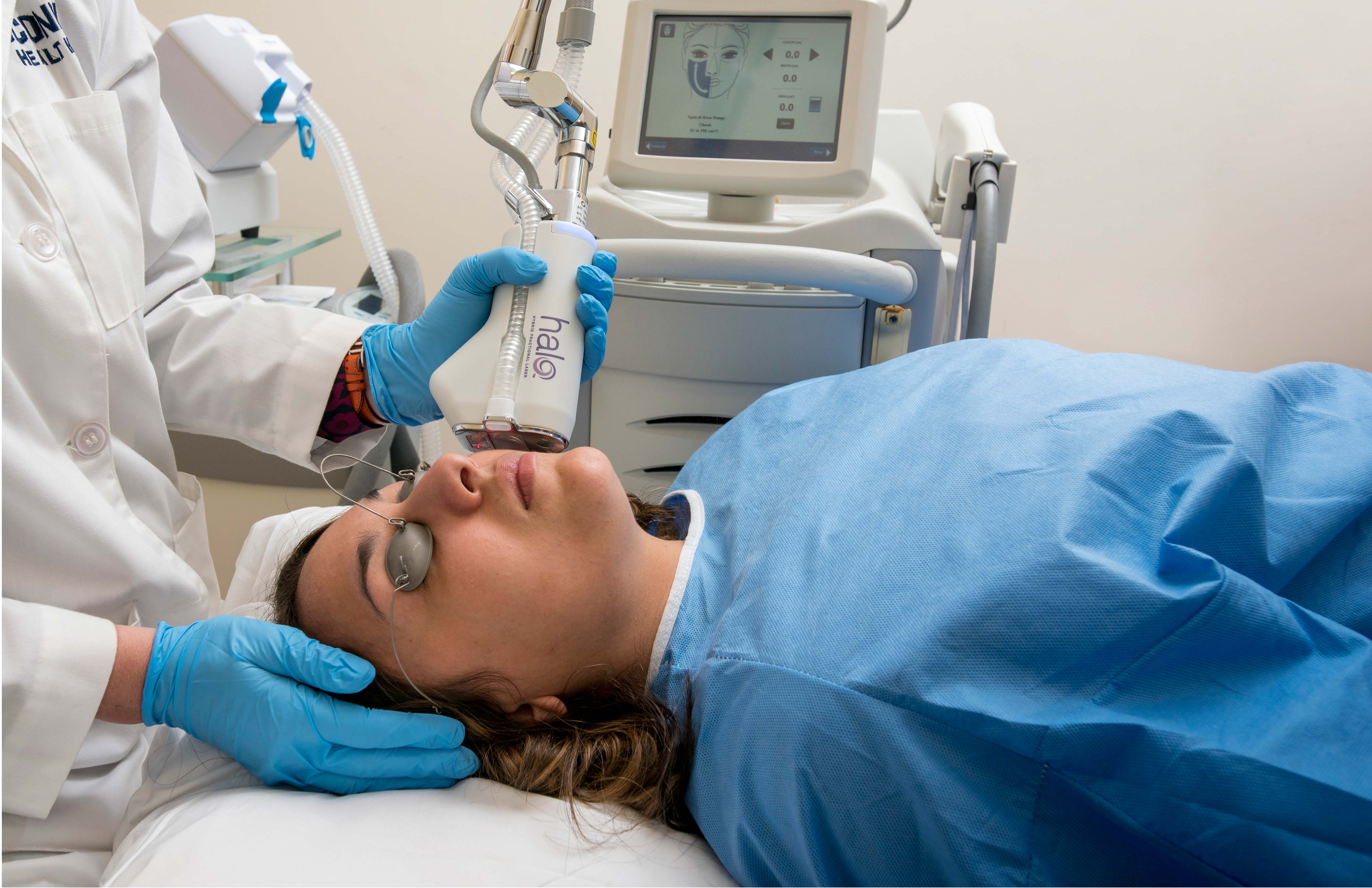A new laser procedure now available at UConn Health can help us overcome visible signs of aging in our skin, with less downtime compared to previously available methods.
It’s known as the Halo hybrid fractional laser, and it works simultaneously on multiple skin layers.

“This laser treatment combines two different wavelengths which are emitted from the laser to rejuvenate two different layers of the skin,” says Dr. Jillian Fortier ’10 (SOM),UConn Health plastic and reconstructive surgeon. “One wavelength affects the deep layer of the skin, or dermis, stimulating an increase in collagen production, which helps restore the elasticity of the skin and prevent the development of wrinkles. The second wavelength targets the more superficial skin, or epidermis, and initiates peeling or sloughing of the skin to revitalize this layer, leaving behind a healthy, glowing top layer of skin to resurface the patient’s face.”
Patients treated with the Halo can expect a downtime of days instead of weeks. They can start applying moisturizer and sunscreen right away and mineral-based makeup the day after the procedure. Initial results start to become visible five days after the procedure, and for most patients the greatest improvements are revealed two weeks to three months after the treatment.
Similar to other laser skin treatments, the Halo works by inducing a controlled degree of damage to the dermis. The body responds by producing more collagen, a protein that, among other things, provides structural support and elasticity in our skin, preventing or reducing the development of wrinkles. The Halo has a sensor that constantly monitors the temperature of the skin to ensure the pulses of energy are safe.
“Because other ablative lasers with a single wavelength only address the dermal layer, the downtime associated with these more traditional lasers is much more significant,” Fortier says. “CO2 lasers provide similar dermal regeneration with increased collagen production, but after this treatment, patients typically have wounds akin to a burn injury on their face, with scabbing and drainage, and they require daily dressing changes for about a week after the procedure, and therefore have at least one week of downtime.”
Candidates for the Halo include those who’ve developed fine lines and wrinkles, enlarged pores, jowling or fullness along the jawbones, irregularity of skin tone, age spots, or pigmentation irregularities from sun damage. Improvements most commonly seen include increasing elasticity and improving texture of skin with softening of fine lines, minimizing pores and lightning of dark spots.
“Starting the next day, patients will experience shedding of the superficial layer of the skin, similar to what you’d see after a sunburn,” Fortier says. “The very thin top layer of cells will start to peel, and as those shed off, the underlying epidermal cells have been stimulated by the laser and will appear more vibrant, having more uniform texture and a natural glow.”
The collagen regeneration and skin rejuvenation typically continues for up to three months after the procedure, with many patients reporting that they’ve seen continued improvement of their skin over the course of the following year.
Patients considering laser treatment should start with a consultation that includes a review of their medical and surgical history and a facial examination to evaluate their specific concerns. Patients who are deemed good candidates for the Halo are scheduled for their procedure. Many patients opt for their treatment on a Friday, to allow them to go through the height of the redness and peeling over the weekend and return to work on Monday. Their procedure starts with the application of a topical numbing medication, and the patient wears protective goggles during the procedure.
“The Halo treatment of the face takes about 45 minutes, and that includes a detailed mapping of the face to determine exactly how much energy needs to be delivered to the skin on each part of the face to optimize results,” Fortier says. “Most people report experiencing minimal pain, or around a one or two out of 10 on a pain scale, during this treatment.”
A Second Setting
The technology, the Sciton Joule laser platform, also enables UConn Health’s plastic and reconstructive surgeons to offer a therapy known as BBL, or BroadBand Light. It targets the cells that are responsible for producing melanin, which causes the pigment of the skin, by delivering multiple wavelengths of intense light pulses to this layer of the skin.
“It doesn’t transmit into the deeper layer of the skin like the Halo does, so it won’t have the long-lasting effects of reducing wrinkles and increasing collagen production, but it is very effective for people who are more concerned with improvement in the pigmentation of their skin,” Fortier says. “It causes the pigment in their dark spots or sun-damaged skin to rise to the surface and eventually slough off. There really is no downtime following a BBL treatment. People have a slight redness of their face afterwards, similar to a sunburn. Many patients have this done on their lunch break and go right back to work immediately after.”
BBL is effective at treating sun spots, liver spots, aging spots, redness from rosacea, acne, or visible blood vessels on the face, and for targeting areas of unwanted hair growth.
While primarily used on the face, both the Halo and BBL are effective treating other parts of the body, such as the neck, chest, or the back of the hands.
Like many cosmetic procedures, health insurance plans generally do not cover these treatments.



